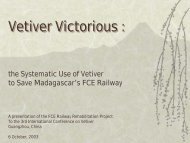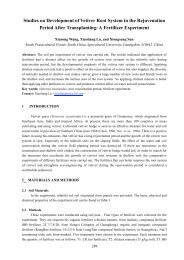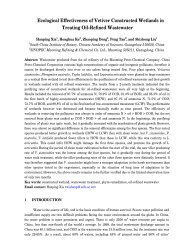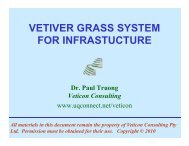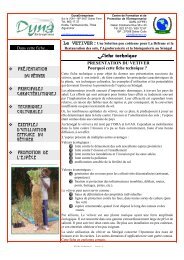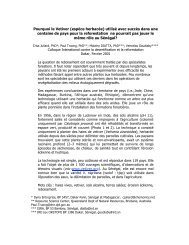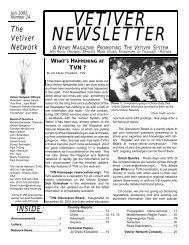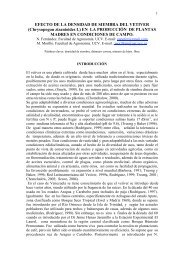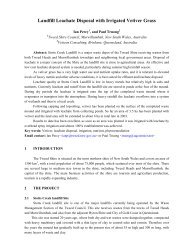Vetiver in Thailand: General Aspects and Basic Studies - The Vetiver ...
Vetiver in Thailand: General Aspects and Basic Studies - The Vetiver ...
Vetiver in Thailand: General Aspects and Basic Studies - The Vetiver ...
You also want an ePaper? Increase the reach of your titles
YUMPU automatically turns print PDFs into web optimized ePapers that Google loves.
2Vitiver <strong>in</strong> <strong>Thail<strong>and</strong></strong>Faek Don (upl<strong>and</strong> vetiver) <strong>and</strong> Faek Hom (lowl<strong>and</strong> vetiver)<strong>Vetiver</strong> is generally known to be orig<strong>in</strong>ated <strong>in</strong> India. It is also found widelydistributed naturally <strong>in</strong> all regions of <strong>Thail<strong>and</strong></strong>. From the botanical exploration, itcould be concluded that there are two species of vetiver <strong>in</strong> <strong>Thail<strong>and</strong></strong>, namely <strong>Vetiver</strong>ianemoralis A. Camus <strong>and</strong> <strong>Vetiver</strong>ia zizanioides Nash.<strong>Vetiver</strong>ia nemoralis, the local vetiver, is distributed ma<strong>in</strong>ly <strong>in</strong> the South-eastAsian region. In <strong>Thail<strong>and</strong></strong> it is commonly found <strong>in</strong> the dry area with moderate tostrong sunlight <strong>and</strong> well-dra<strong>in</strong>ed soil, so it is called upl<strong>and</strong> vetiver or “Faek Don” <strong>in</strong>Thai (Faek = vetiver <strong>and</strong> Don = upl<strong>and</strong>). <strong>The</strong> leaf of Faek Don is 35-80 cm long <strong>and</strong>0.4-0.8 cm wide <strong>and</strong> pale green <strong>in</strong> color. <strong>The</strong> color of the lower leaf surface is thesame as that of the upper surface but somewhat paler. <strong>The</strong> septum can not be seen,whereas the midrib is hard <strong>and</strong> forms the prom<strong>in</strong>ent ridge. <strong>The</strong> leaf texture is coarselyrough <strong>and</strong> slightly waxy. Its roots have no fragrance <strong>and</strong> can be 80-100 cm long <strong>in</strong>one year old vetiver.<strong>Vetiver</strong>ia zizanioides or lowl<strong>and</strong> vetiver, is called “Faek Hom” <strong>in</strong> Thai (Hom= fragrant) because of its fragrant root which can be used for volatile oil extraction.Faek Hom is able to adapt very well <strong>and</strong> grow well <strong>in</strong> various environmentalconditions. Its leaf is 45-100 cm long, 0.6-1.2 cm wide, curved on the upper surface<strong>and</strong> flat near the apex with a smooth <strong>and</strong> waxy texture. <strong>The</strong> leaf color is dark green<strong>and</strong> the lower surface is paler than the upper surface. <strong>The</strong> septum can be seen clearlyespecially at the base <strong>and</strong> middle part of the blade, whereas the midrib is not clearlyseen. <strong>The</strong> roots of Faek Hom are longer than those of Faek Don, the one year oldvetiver can produce over 1 meter long roots.Both Faek Don <strong>and</strong> Faek Hom pose dist<strong>in</strong>ct ecological variation which makesthem adaptable to different habitats. <strong>The</strong>refore, they are commonly found <strong>in</strong> allregions of <strong>Thail<strong>and</strong></strong> <strong>and</strong> there are many ecotypes. Thai vetiver ecotype was namedafter the prov<strong>in</strong>ce where it was first found, e.g., Ratchaburi, Surat Thani, Roi Et, Loei,Kamphaeng Phet. <strong>The</strong> Department of L<strong>and</strong> Development has done a comparativestudy of 28 vetiver ecotypes, 11 ecotypes of Faek Don <strong>and</strong> 17 ecotypes of Faek Hom.As the result, 10 ecotypes have been proved suitable to grow <strong>in</strong> various soil types <strong>and</strong>regions (Tables 1 <strong>and</strong> 2) (ORDPB, 2000). This <strong>in</strong>formation is useful for research <strong>and</strong>development on vetiver <strong>in</strong> <strong>Thail<strong>and</strong></strong>.Table 1. <strong>Vetiver</strong> ecotypes suitably grow <strong>in</strong> various soil typesSoil type Faek Don Faek HomS<strong>and</strong>y soil Nakhon Sawan, Kamphaeng Kamphaeng Phet 2, Songkhla 3Phet 1, Roi Et, RatchaburiClay loam soil Loei, Nakhon Sawan, Ratchaburi, Surat Thani, Songkhla 3Kamphaeng Phet 1, PrachuapKhiri KhanLeterite soil Prachuap Khiri Khan, Loei Kamphaeng Phet 2, Songkhla 3Surat Thani, Sri Lanka




